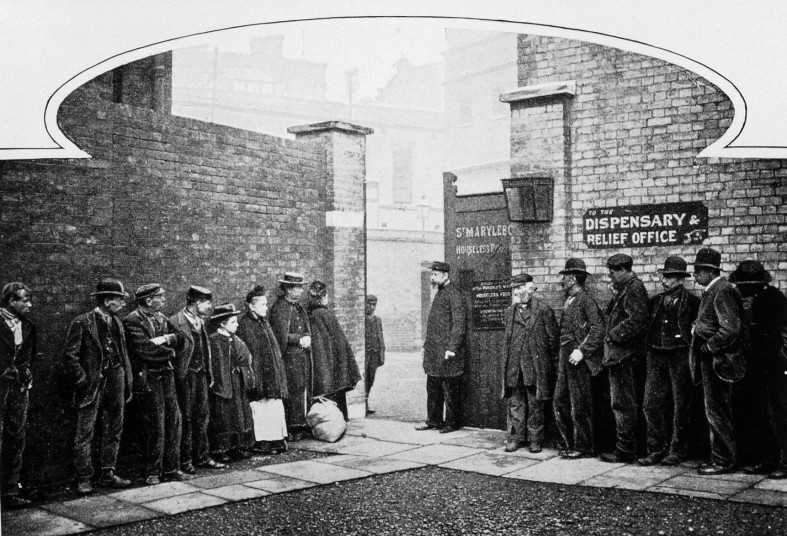
People queuing outside St Marylebone workhouse, about 1900
Last time I wrote about the life of Martha Stickley up to the point where she married William Lane in 1889. By this time she was 33 years old, had four illegitimate children and had spent most of her adult life in Wallingford Union Workhouse.
Martha must have known William Lane for some time before they married as he was also living in the workhouse. The census places him there in 1881 with five children, Ellen (12), Elizabeth (9), Sarah (7), Louisa (5) and William (3). William’s first wife Ellen had died in 1879 and he probably couldn’t manage the children on his own so took them to the workhouse.
By 1891 William and Martha Lane had left the workhouse and were living in Union Terrace, Wallingford. The name of this terrace makes me think that it must have been linked to the workhouse – probably built and managed by the Wallingford Union. The houses were situated a short distance from the workhouse and I think they are in what is now St Nicholas Road. There are some older houses still surviving in this street, set back from the road near the school, which are in the right position to be the remains of Union Terrace. My guess is that Union Terrace was low rent housing to help families like the Lanes leave the workhouse and live more independently. At the time of the 1891 census, 12 families were living in Union Terrace, and most were living in fairly crowded conditions.
The Lane household consisted of:
- William Lane, 56, general labourer.
- Martha Lane, 40
- Elizabeth Lane, 19, Charwoman
- Sarah Lane, 17, works at home
- William Lane, 13, Ag Lab.
- Thomas Lane, 2,
- Martha Stickley, step daughter, 4.
Elizabeth, Sarah and William are William’s children from his first marriage. His daughters Ellen and Louisa are both away from home by this time. I haven’t been able to track down Ellen but in 1891 Louisa was 15 years old and working as a servant in Oxford.
Martha’s two older children, Elizabeth and Joseph, were now aged 19 and 13 respectively. Elizabeth was still in the workhouse and Joseph had been sent to a training ship at Portishead, near Bristol. I’ll say more about them another time as they both have stories to tell, but for now it seems clear that when Martha married William Lane, some of his older children left the workhouse and lived with them but Martha’s older children did not. This might have been because William’s children had been born legitimately to his first wife, whereas Elizabeth and Joseph Stickley were both born illegitimately. The Victorians really did seem to believe in punishing children for things they had no control over.
Although life was crowded in the ‘two up, two down’ cottage in Union Terrace, it must have been considerably better than the workhouse. Martha and William went on to have three more children over the next few years, Henry (born in 1892), Esther (1895) and Harriet (1897).
Ten years later in 1901, the census shows that William and Martha Lane are still in Union Terrace and they have six of their children living with them at this time. Their youngest daughter Harriet died a few years later, aged 11. In this census and the following one in 1911, Martha’s daughter, Martha, is listed as Martha Lane (rather than Martha Stickley) which makes me wonder whether she might have been William’s daughter even though she was born three years before they married. Alternatively she could just have taken the name Lane because William Lane was a father figure to her whether or not he was her biological father.
At the next census point in 1911 the Lane family remain in Union Terrace, this time with only three of their children living with them. By this time William was 77 and Martha was 55. William Lane died a year later in 1912 and Martha lived a further 20 years, possibly still in Union Terrace although I have no proof of that – further evidence might come to light when the 1921 census is released in a couple of years time.
Looking back at Martha’s life, the main feature of it seems to have been poverty. She was born into a poor family of agricultural labourers. She was in the workhouse for several years as a young woman and then lived in a small terraced house with her husband and several of their combined twelve children. Martha would also have had to deal with the consequences of being an unmarried mother from the age of 16 onwards and no doubt people looked down on her, called her names and thought she was immoral and/or stupid. The saddest thing is that there was nothing unique about Martha, and many other women would have had equally difficult lives in the 19th and early 20th centuries before the advent of the welfare system that we are so fortunate to have today – I know it is not perfect but it is in a completely different league to the Victorian workhouse.
Photo credit
People queuing outside St Marylebone workhouse in London, by Wellcome collection – https://wellcomecollection.org/works/xtevmfsg CC-BY-4.0, CC BY 4.0, https://commons.wikimedia.org/w/index.php?curid=36015158
One thought on “Martha and William Lane”